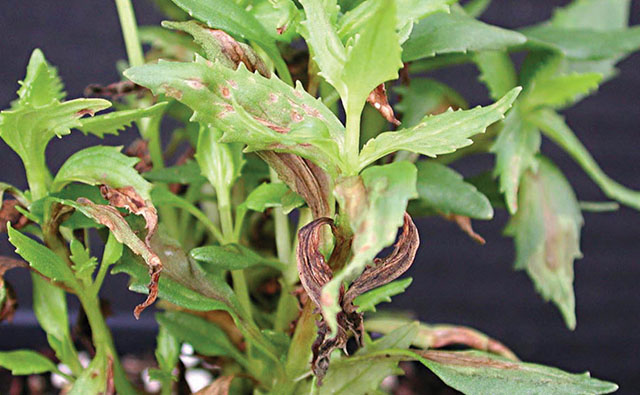Industry News, Agriculture & Feed
4 Pathogens to Prepare For in 2017

Industry News, Agriculture & Feed

Image: Green House Grower
Diseases in the greenhouse are frequently spread via contaminated plant material. Diseased plant material should be removed and destroyed, but it is also important to note that plants adjacent to symptomatic plants may be harboring a bacterium, even if they are not showing symptoms. Further, sanitation is always a critical component of disease control.
Margery Daughtrey, a Senior Extension Associate at Cornell University’s Long Island Horticultural Research and Extension Center, says there are four pathogens in particular growers should be mindful of this year.
“There is no curing any of these: one must be quick to recognize these diseases and then discard the affected plants and protect the rest,” Daughtrey says.
This is one of the two common viruses vectored by Western flower thrips. Recently it has been seen causing symptoms in nemesia, and causing brown spots on leaves, brown patches at the base of leaves, and browning along the stems. Begonias and basil are two other crops that have been seen with INSV symptoms recently. The virus has a huge host range, and might affect virtually any herbaceous crop. Symptoms in different crops vary from spots to ringspots to stem cankers, in various shades from white to yellow to brown to black. After verifying these symptoms through a lab or an in-house test, affected plants should be destroyed and thrips management should be stepped up.
This virus creates symptoms similar to those of INSV (and the two are closely related, both spread by the Western flower thrips). INSV is more familiar to greenhouse growers, but its close relative TSWV has been appearing in the industry recently and is just as important to avoid. It has been showing up on osteospermum and vinca in recent years, as well as other plants.
You would expect yellow spots, yellow mottling, brown spots, or ring spots most often, but many variations on these symptoms are possible. After verifying these symptoms through a lab or an in-house test, affected plants should be destroyed and thrips management should be stepped up.
This bacterium affects kale and cabbage, and is perfectly willing to affect ornamental kale and ornamental cabbage. It is seed-borne, which makes it insidious. The bacteria can spread from plant to plant by handling or by overhead irrigation. It is worth scouting for leaf spot symptoms so that infected trays can be discarded. Treatments to protect plants would be copper sprays or sprays of a Bacillus subtilis or B. amyloliquefaciens material.
This bacterium affects begonias, causing small, round spots on some and large wedges at the edge of leaves and even stem rot on others. It affects all types of begonia, but is not usually seen on the semperflorens types most common in the bedding plant industry. It is more of a problem on Rieger begonias, Nonstops, Rex begonias, and other types produced from cuttings. It is spread by handling and splashing. Treatments to protect plants include copper sprays or sprays of a Bacillus subtilis or B. amyloliquefaciens material.